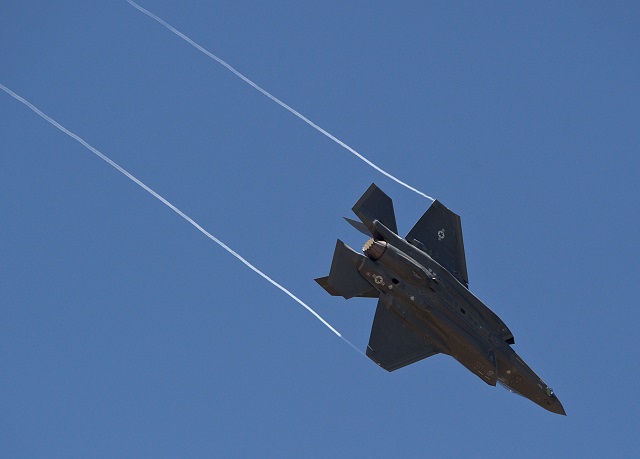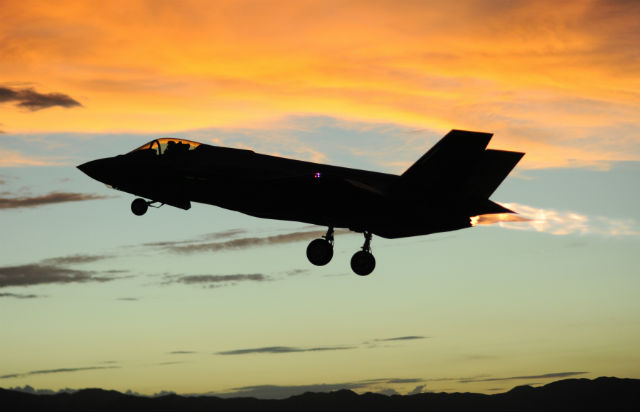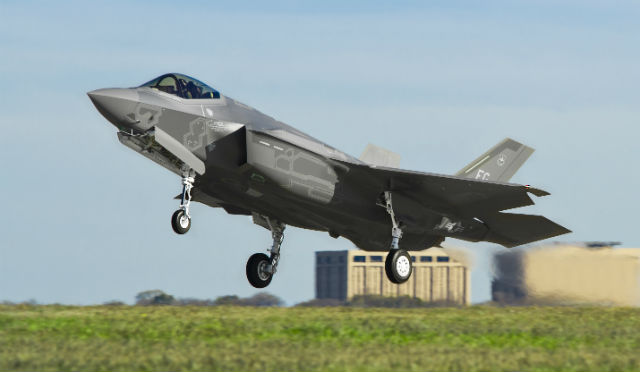Five years after the projected initial operational capability (IOC) date, the Air Force has declared the first 15 Lockheed Martin F-35As assigned to the 34th Fighter Squadron at Hill AFB are capable of performing a basic set of combat missions.
While the US Marine Corps F-35B reached IOC last summer, the F-35A’s IOC announcement represents a significant milestone for both the US and international partners involved in the 15-year development of the Joint Strike Fighter. The USAF has committed to buy 1,763 F-35As alone, while the Marine Corps and Navy have a combined to order 640 B- and C-variants respectively. Most international partners intend to procure the A variant, which is now projected to cost $106 million per copy over the life of the acquisition, according to a 2016 Defense Department selected acquisition report.
In a 2 August media briefing at the Pentagon, the US Air Force’s chief of Air Combat Command Gen Herbert "Hawk" Carlisle tempered the milestone announcement, saying the aircraft still needs significant work that will come with impending software and hardware upgrades. Carlisle hailed the F-35’s ability to gather information, fuse data from multiple sources and increase the pilot’s situational awareness. But several of the capabilities that are supposed to make the aircraft the giant, flying sensor the Air Force has billed will not come online until software blocks 3F and 4 are available in 2018 and 2021, respectively.

The IOC was declared only after a months-long rush to modify a siphon fuel tank. Flight tests last year revealed that air can inadvertently enter the siphon fuel tank, causing it to rupture under certain flight maneuvers. The discovery forced the USAF to limit the F-35A to 3g manoeuvres. The F-35A will be capable of 9g loads with Block 3F software, but the current Block 3I standard can handle up to 7gs. Maintainers at the Ogden Air Logistics Centre completed modifications in late-June on the 12th F-35A, the minimum number required by the ACC to declare IOC.
Other software and hardware design limitations are still being resolved. A software fix is scheduled for delivery in October that will make it possible for an F-35 to fuse sensor data coming from other F-35s. International partners are still waiting for policy changes to have access to the same mission data files loaded into US F-35A cockpits. All F-35 pilots weighing less than 61.7kg (136lb) are banished from the cockpit until Martin-Baker can complete a modification to the ejection seat that should reduce the risk of injury upon ejection.
The fighter faced still more challenges during a recent interim readiness assessment, though the aircraft’s capabilities will improve with the Block 3F software load, Carlisle said.
“There’s still some challenges with the displays on the scope and how you depict information,” he said. “When you fuse that many sensors together … to display that and continue to make it intuitive and logical to the person that’s flying the airplane, we’re still working on that.”
Block 3F will include upgrades such as a larger synthetic aperture radar map and will be delivered to the fleet in 2017. The Block 4 modernisation will deliver 80 new capabilities and 17 weapons that were not part of the programme’s original go-to-war plan for the F-35A in 2001, according to an April Government Accountability Office report.
Block 4.1 capabilities will include electronic warfare improvements, cockpit navigation upgrades and a maritime identification capability for the radar, the programme office says. AIM-9X missile integration is also planned for Block 4.1, as is the Small Diameter Bomb II, which has faced delays and has not yet achieved IOC. Block 4.2 will enhance interoperability with Link 16 data link and an advanced electro-optical targeting system. Still more upgrades would extend the power and connectivity of the aircraft could be available, but are not yet funded. Pratt & Whitney has proposed a block upgrade for the F-35A with 10% more thrust after 2019. Another technology is needed for the F-35 to share data with other aircraft types with a low risk of jamming or interception.

In addition to software upgrades that will fill current gaps in unit intelligence support, the fighter still lacks an infrared pointer that allows the pilot to confirm the correct target with the ground controller. The fighter is able to accomplish a basic close air support mission, but Carlisle cautioned that there is still work to be done to bring the aircraft to its full potential.
Without its full operational capability, which is set for 2021, the F-35A in its current form amounts to a show of force. Today, Carlisle could supply the fighter to a combatant commander if the aircraft were requested for operations in the Middle East, but the F-35A’s planned rotation in that theater is farther down the road.
Still, the F-35’s mere presence in Europe would not only be enough to boost allies’ confidence, but send a message to adversaries as well, Carlisle said. The fighter would not serve to provoke enemies, but to act as a deterrent, he added.
“I mentioned I would like to deploy it in both the European and Pacific theater,” he said. “Within 18 months I’ll try to get to both those theaters.”
Although the fighter will have to wait for the 3F and 4 block upgrades for many of its promised capabilities, the IOC announcement has closed the first chapter on a troubled programme that has faced several delays and more than one rebaselining. The original IOC for the F-35A was scheduled in 2011. A weight-saving redesign, production bottlenecks and technical glitches plagued the programme’s managers and accountants from 2004 to 2012. In the last four years, costs and schedules have stabilized, but the damage was not reversed. In 2001, the average cost of an F-35A adjusted for inflation was expected to be $54 million, but is now roughly twice that amount.
Despite the symbolic nature of IOC, the milestone is a good sign the programme is past most of its problems, said Todd Harrison, a defence budget analyst at the Center for Strategic and International Studies in Washington.
“I’m sure there will still be some kinks that come up in the system in the coming years, but for the most part I think this means the program has stabilized,” he said. “They’re on a good trajectory, most of the potential for major cost overruns and technical challenges are now behind us.”

While the programme is on the right track, Harrison expressed skepticism over whether the services would meet their full production rates for the US buy of the F-35. Other Defense Department modernisation priorities, which will peak during a projected acquisition “bow wave” in the 2020s, could push the F-35 buys out, he said. However, the Defense Department will not be forced to make those production decision until then.
Carlisle confirmed that decision will be made later, but noted the air force needs more planes at a faster rate to replace its aging fleets. While he would like to pursue 80 aircraft per year purchase, current budget constraints could force that buy to 60 fighters, not including purchases by foreign governments. The slower pace will make it harder for the JPO to achieve a cost goal of $85 million per F-35A by the end of the decade.
“My concern is buy rate,” he said. “I need more sooner to replace legacy airplanes and airplanes that are going to require money to do service life extension and to do capability increases if I don’t replace them with F-35. So I would like to see the number go up to at least 60 if I can.”
Source: FlightGlobal.com










































